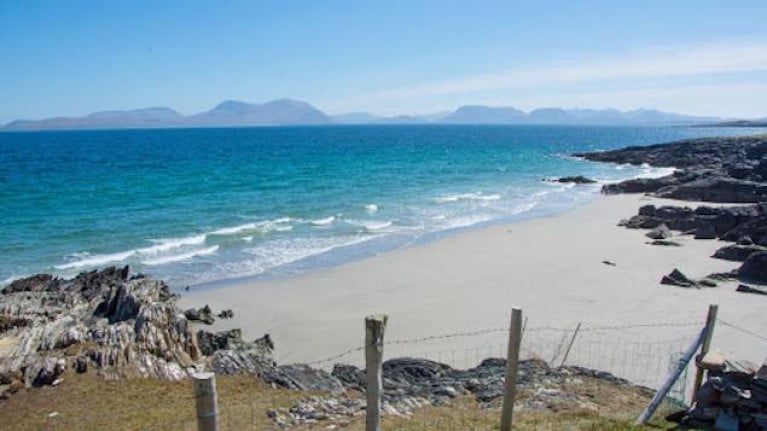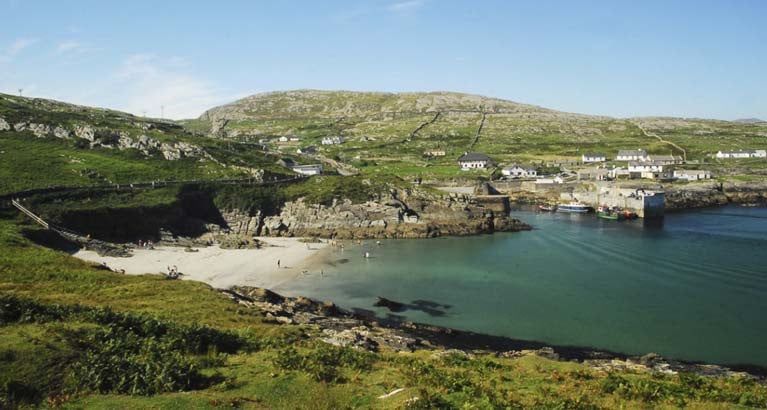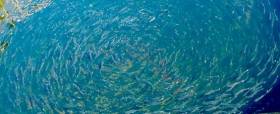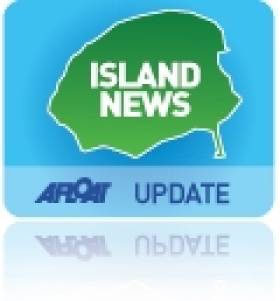Displaying items by tag: Inishturk
New Fast-Ferry Service to Inishturk off Co. Mayo is Launched
A new fast-ferry service to Inishturk Island off Co. Mayo has been launched.
The new Inishturk passenger ferry service writes Connacht Telegraph, has a journey time of 25 minutes that connects the mainland with the island that is 5km long and 2.5km wide.
At just a quarter of an hour's passage time, this is the fastest ever ferry service to Inishturk, which is now part of the subsidy service.
Running the faster service is the O'Grady family who are natives of Clare Island. Their new boat Whispering Hope operates on the route from Roonagh Pier outside Louisburgh to Inishturk.
The Whispering Hope with a 12 passenger capacity joined the route's well-known ferry the Pirate Queen with 96 passengers.
The Arklow Marine Services built ferry takes 48 minutes to travel the Roonagh Pier-Inishturk route where passengers can take in the views or use of a lounge below deck.
Last Thursday the first passengers boarded the Whispering Hope before setting out into the Atlantic to reach the island that has wall-like cliffs to the northwest.
The O'Grady owned Clare Island Ferry Co. service, likewise of Inishturk, is linked to Roonagh as well to using both a fast-ferry and a second ferry which at times is in cargo-only mode and is capable of carrying vehicles.
The Mayo offshore island of Inishturk is to secure a new helipad for use by Irish Coast Guard air-sea rescue helicopters.
Funding of over €357,000 for the construction of the helipad has been approved by Minister for Rural and Community Development Heather Humphreys.
She says the Department of Rural and Community Development investment will “provide a vital resource for the Irish Coastguard to access the island in an emergency”.
Inishturk lies in outer Clew Bay, some nine miles or about 15km off the Mayo coast between Inishbofin and Clare Island.
It has a population of between 51 and 60 people, and made international headlines in 2016 when it was reported to have offered a refuge to US citizens who did not vote for Donald Trump as president.
Former island development officer Mary Catherine Heanue subsequently said she never actually issued the appeal to north Americans, which was attributed to her in news reports, but said the response on social media did benefit the island’s tourism.
"We would never actually turn anyone away, not even Mr Trump," Ms Heanue, who runs Ocean View guesthouse with her husband Bill, said at the time.
The island has a mixed fishing and farming economy and daily ferry crossings from Roonagh, Co Mayo.
Ms Humphreys said the funding she had approved would cover up to 90% of the cost of the helipad project, with Mayo County Council providing the balance.
She announced an air service contract worth €4.9 million for the Aran islands and over €2 million in funding for road projects on the islands off Donegal.
“This helipad will be a vital resource to the Irish Coastguard, providing them with a safe place to land on the island itself,” she said.
“Making our islands more sustainable is a key priority of mine as minister,” she said.
“I have no doubt that this particular funding will come as welcome news for Inishturk, and I want to also commend the Irish Coast Guard for the vital work they do,”she said.
Inishturk Islander Will Celebrate 89th Christmas at Home After Achill Island RNLI Medevac
Inishturk islander John O’Toole will enjoy his 89th Christmas at home with his wife Mary, his children and grandchildren in the coming weeks.
He and his family won’t take this for granted. however, since John spent several weeks in hospital during the summer after his medevac by Achill Island RNLI when he became seriously unwell in June this year.
As thanks to the lifeboat crew that came to his aid, John and his family are supporting the RNLI’s Christmas Appeal.
John spent almost two months being treated for his illness in Mayo University Hospital before recuperating in a nursing home and finally becoming well enough to return home courtesy of Achill Island RNLI to Inisturk in August.
Speaking about her father’s dramatic recovery, John’s daughter Annie Maher said: “On that day in June when Dad took ill, the Achill Island lifeboat was called to transfer Dad from home to the mainland to get medical attention at Mayo University Hospital.
“Without the quick response of the lifeboat on that day, it may have been a very different outcome.”
Supporting the RNLI’s Christmas Appeal comes easy to the O’Toole family, who have been long-standing supporters of the charity that saves lives at sea.
Having John at home brings back fond memories of Christmases in the past, and that unique relationship that exits between the islanders and the RNLI.
 File image of Achill Island RNLI’s all-weather lifeboat | Credit: RNLI
File image of Achill Island RNLI’s all-weather lifeboat | Credit: RNLI
Annie recounts stories of how the young children on Inisturk would donate all the money they gathered on their traditional Wren Boys Day collection to the RNLI, which they affectionally refer to as ‘the lifeboat’.
She said that the islanders were always assured that even in really bad weather conditions, ‘the lifeboat’ would always come to their aid. “What a wonderful service it is to all still living on the islands around Ireland.”
She also spoke about the RNLI collection box which was always on the counter in the local pub, and the islanders happily popped their change into it.
“Dad has made a remarkable recovery following his return home,” Annie said. “He enjoys daily short walks with mum and the dogs while keeping an eye on the sheep. He is looking forward to spending time with family and friends and maybe have a little glass or two of rum.”
She concluded: “Dad, Mum and all of us understand the commitment and dedication of the Achill lifeboat crew and all involved with the lifeboat. We wish them all a very Merry Christmas and safe New year. May God watch over them all while at sea.”
These callouts would not be possible without donations from the RNLI’s generous supporters, helping to fund the essential kit, training and equipment needed by lifeboat crews all year round.
Despite the disruption caused by the pandemic, lifeboat crews have remained on call, available to launch at any hour, day, or night, to help those in trouble at sea.
Through people supporting this year’s Christmas appeal, the RNLI can continue to operate the lifesaving service and work towards the charity’s goal, to save every one.
To make a donation to the RNLI’s Christmas Appeal, visit RNLI.org/Xmas
Over four years ago, the Mayo island of Inishturk was inundated with inquiries after the word went out that it was offering a safe haven for North Americans who had not voted for Donald Trump.
Now, even Mr Trump himself might find it hard to find refuge on the island, as all its available rented property is booked out.
US citizens did not take up the island’s reported offer in 2016, which had prompted visits from an American network film crew and calls from The New York Times and CNN.
German families
However, several German families have moved there over the past year, ensuring the one island-born child on the primary school roll has company.
The “Trump refuge” torch was lit back in Spring 2016 when the island campaigned for more pupils for its primary school.
It advertised its “excellent broadband”, and a mixed fishing and farming economy – along with 12 weekly ferry crossings on the 14.5km transit between it and Roonagh, Co Mayo.
Inishturk community development co-ordinator Mary Helena O’Toole says the island has “moved on from all that now”, and there is no available rented property anyway.
Good tourist season
The island had a very good tourist season this year, in spite of guesthouses being closed due to Covid-19. she says
"I think a lot of people discovered our island for the first time during day trips, and loved the environment, "she says.
One of the new German residents, Irena Meilick, is delighted with the move that she and her husband Bruno made to the island from Bavaria.
Her husband is a web designer, and can work remotely, and the eldest of their four boys is at the primary school. A second German family has three children at the school.
“I think what the island needs is children, and I hope more islanders who have left move back and rear their families here,” she says.
Joe Biden connections
While Inishturk’s mainland county of Mayo has welcomed the election of Joe Biden – great-great-great-grandson of Famine emigrant Edward Blewitt - south Connemara has also issued its own good wishes to his campaign manager, Jen O’Malley Dillon (44).
Ms O’Malley Dillon has connections with Tír an Fhia in Co Galway, where her great grandparents John O’Malley and Bríd Ní Chonghaile came from.
John Bhaba Jeaic Ó Conghaile, director of Ionad Oidhreachta Leitir Mealláin – the Lettermullen Heritage Centre, with a strong maritime dimension – has congratulated her on the success of her campaign.
Mayo Islanders Say They Cannot Risk Mobile Phone Mast Repair Due to Health Concerns Over Covid-19
Islanders on Inishturk, Co Mayo, say they cannot risk essential repairs being carried out to a storm-damaged mobile phone transmitter for the west coast due to the risk of contracting the COVID-19 virus.
Inishturk development manager Mary Helena O’Toole said that some 60 per cent of the population on Inishturk is over 65 years of age, and cannot be exposed to any risk.
"Islanders are also affected by the loss of mobile phone coverage, but we believe our health has to be the priority, at least while these current measures are in place,” she said.
However, a former Fine Gael councillor Austin Francis O’Malley says many residents on the south Mayo and Connemara mainlands have limited or no phone cover, and fear not being able to call a doctor if the mast is not repaired.
The transmitter on Inishturk, 15 km west of Mayo, was damaged during Storm Dennis in mid-February, which has been classified as one of the most intense extratropical cyclones ever recorded.
Both islanders and mainland residents extending from the little Killary in north Connemara up to an area close to Louisburgh, Co Mayo, lost mobile phone cover in some instances.
Mr O’Malley said that he first became aware of the problem when he encountered difficulties in alerting members of the group water scheme he manages.
“We appreciate the position of the islanders on Inishturk, and we have to credit them for refusing access, but Vodafone did have time to fix this before the COVID-19 restrictions came in,” he said.
Mr O’Malley said he had contacted acting rural affairs minister Michael Ring about the issue.
“I am in the middle of lambing sheep, and I wasn’t able to contact my son by mobile phone when he was close by,” he said. “However, it is elderly and vulnerable residents I am most concerned about, as many don’t have landlines anymore.”
It is understood that initial technical work on the mast was underway, but had not been completed when restrictions were introduced to curb the spread of the COVID-19 virus.
Vodafone was informed by Inishturk residents that they could not permit a technician travelling by ferry from Roonagh Pier in Mayo to land, due to risks of infection.
The technician was refused on two attempts to travel.
The ferry service has cut back to three sailings a week, with only once a week return trips, and is not taking any visitors.
Vodafone Ireland said it was “aware of a network issue currently affecting some of our customers in parts Galway and Mayo, due to storm damage on Inishturk”.
“We are working hard to resolve this issue and our network repairs crew are standing by to carry out works and will abide by all COVID-19 health and safety measures,” it said.
“Discussions are ongoing with third parties on the island in relation to access,” it said. It said it “sincerely apologise for the inconvenience caused”, and thanked people for their patience.
Community Concerns Over Loss Of Galway & Mayo Islands Doctor
Two islands off Galway and Mayo face the prospect of no local doctor with the pending retirement of a mainland-based GP.
As the Connacht Tribune reports, Dr Ciarán McLoughlin will end his services to the community on Inishbofin and Inishturk next week after retiring from his Clifden practice earlier this year.
But as of a week ago, the HSE had not found a replacement full-time GP, and it continues to advertise for the position.
Inishturk Fish Farm Application Tops €200k
#FishFarm - Bord Iascaigh Mhara (BIM) has spent over €200,000 on its application for a proposed salmon farm off Inishturk in Co Mayo, as the Irish Examiner reports.
The planned project, much like the withdrawn proposal for Galway Bay for an even larger-scale fish farm, has faced opposition from local anglers and conservationists, who have lambasted the €216,000 spend — on an environmental study, legal advice and communications consultancy — as a ‘waste’ of taxpayers’ money.
“It is appalling that BIM has wasted more than €216,000 on a salmon farm licence application for Inishturk when it should be the salmon farm operator who is required to apply,” said Billy Smyth of lobby group Galway Bay Against Salmon Cages.
BIM, the State agency for Ireland's sea fisheries and aquaculture, says the Inishturk project could produce 4,000 tonnes of farmed salmon annually, and create as many as 75 direct and indirect jobs.
The Irish Examiner has more on the story HERE.
Clifden Lifeboat Assists In Medevac From Inishturk
#RNLI - An island medical evacuation was carried out yesterday (Monday 26 September) by the volunteer crew of Clifden RNLI on the Mersey class all-weather lifeboat Fisherman's Friend.
In calm seagoing conditions, the lifeboat was launched at 1.15pm to attend to a man who had experienced a fall at the north end of Inishturk off the Mayo coast.
On arrival at the pier in Inishturk, the casualty was taken aboard the lifeboat and transferred to Cleggan pier, where he was moved to a waiting ambulance with the assistance of the Cleggan Coast Guard Unit.
Speaking following the callout, Clifden RNLI coxswain Alan Pryce said: “We were glad to be able to transfer this man safely to shore and we wish him a speedy recovery.
“The capability of the all-weather lifeboat in carrying out long-range shouts such as this one is reassuring, both for us as volunteers and all those who live on and visit our offshore islands.”
Mayo Island Residents Face Christmas Without Medical Cover
#IslandNews - Some 58 people on an island off west Mayo face their first Christmas in decades without medical cover, as The Irish Times reports.
The residents of Inishturk have been left in the lurch as the HSE West has not filled the vacant nursing post on the island, following the retirement of the community's previous nurse after 30 years in September.
Since then the island has only had two days of medical cover, according to local community worker Mary Heanue – who blamed the wider issue of cutbacks in services to Ireland's offshore island communities.
And last night Clifden RNLI was tasked to provide "urgent and immediate" medical attention to an elderly resident on the island, some 14km off the Mayo coast.
The Irish Times has more on the story HERE.



































































